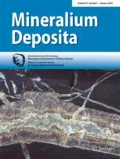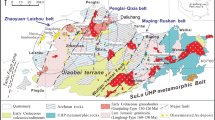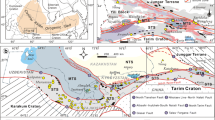Abstract
The Homestake gold deposit, located in the Black Hills, South Dakota, USA, is one of the largest known hydrothermal gold deposits globally, with total mining production exceeding 40 Moz Au. Rhenium–osmium geochronology of ore-associated arsenopyrite and pyrrhotite was performed in an effort to delineate the timing of gold mineralization in relation to known tectonothermal events in the northern Black Hills. Arsenopyrite yields a rhenium–osmium (Re–Os) age of 1,736 ± 8 Ma (mean squared weighted deviation = 1.6), consistent with existing age constraints for gold mineralization, whereas Re–Os pyrrhotite data are highly scattered and do not yield a meaningful mineralization age. This is taken to indicate that the Re–Os arsenopyrite chronometer is robust to at least 400°C, whereas the Re–Os pyrrhotite chronometer is likely disturbed by temperatures of 300–350°C. The Re–Os arsenopyrite age and initial Os ratio (0.28 ± 0.15) are interpreted to indicate that gold was introduced at ca. 1,730 Ma, coincident with the onset of exhumation of crustal blocks and, possibly, the earliest intrusive phases of Harney Peak granite magmatism. New in situ U–Pb monazite analyses from an aplite dike in the east-central Black Hills indicate that granite magmatism was a protracted event, persisting until at least ca. 1,690 Ma.











Similar content being viewed by others
References
Arne DC, Bierlein FP, Morgan JW, Stein HJ (2001) Re–Os dating of sulfides associated with gold mineralization in central Victoria, Australia. Econ Geol 96:1455–1459
Bachman RL, Sneyd DS, Campbell TJ (1990) The Crook Mountain Granite and its possible relation to Early Proterozoic gold mineralization, Homestake Mine, Black Hills, South Dakota. Abstr Programs Geol Soc Amer, Rocky Mountain Section 22:A2
Birck JL, RoyBarman M, Capmas F (1997) Re-Os measurements at the femtomole level in natural samples. Geostand Newsl 20:19–27
Brenan JM, Cherniak DJ, Rose LA (2000) Diffusion of osmium in pyrrhotite and pyrite: implications for closure of the Re–Os isotopic system. Earth Planet Sci Lett 180:399–413
Caddey SW, Bachman RL, Campbell TJ, Reid RR, and Otto RP (1991) The Homestake gold mine, an early Proterozoic iron-formation-hosted gold deposit, Lawrence County, South Dakota. United States Geological Survey Bulletin 1857-J, 67 pp
Chinn W (1969) Structural and mineralogical studies at the Homestake Mine, Lead, South Dakota. PhD dissertation, University of California, Berkeley, California
Cohen AS, Waters FG (1996) Separation of osmium from geological materials by solvent extraction for analysis by TIMS. Analytical Chimica Acta 332:269–275
Connolly JP (1927) The Tertiary mineralization of the northern Black Hills. South Dakota School of Mines and Technology Bulletin 15, 130 pp
Creaser RA, Papanastassiou DA, Wasserburg GJ (1991) Negative thermal ion mass spectrometry of osmium, rhenium, and iridium. Geochim Cosmochim Acta 55:397–401
Dahl PS, Foland KA (2008) Concentric slow cooling of a low-P–high-T terrane: evidence from 1600–1300 Ma mica dates in the 1780–1700 Ma Black Hills Orogen, South Dakota, U.S.A. Am Mineral 93:1215–1229
Dahl PS, Frei R (1998) Step-leach Pb–Pb dating of inclusion-bearing garnet and staurolite, with implications for Early Proterozoic tectonism in the Black Hills collisional orogen, South Dakota, United States. Geology 26:111–114
Dahl PS, Holm DK, Gardner ET, Hubacher FA, Foland KA (1999) New constraints on the timing of Early Proterozoic tectonism in the Black Hills (South Dakota), with implications for docking of the Wyoming province with Laurentia. Geol Soc Amer Bull 111:1335–1349
Dahl PS, Hamilton MA, Jercinovic MJ, Terry MP, Williams ML, Frei R (2005a) Comparitive isotopic and chemical geochronometry of monazite, with implications for the U–Th–Pb dating by electron microprobe: an example from the metamorphic rocks of the eastern Wyoming Craton (U.S.A.). Am Mineral 90:619–638
Dahl PS, Terry MP, Jercinovic MJ, Williams ML, Hamilton MA, Foland KA, Clement SM, Friberg LM (2005b) Electron probe (Ultrachron) microchronometry of metamorphic monazite: unraveling the timing of polyphase thermotectonism in the easternmost Wyoming Craton (Black Hills, South Dakota). Am Mineral 90:1712–1728
Dahl PS, Hamilton MA, Wooden JL, Foland KA, Frei R, McCombs JA, Holm DK (2006) 2480 Ma mafic magmatism in the northern Black Hills, South Dakota: a new link connecting the Wyoming and Superior cratons. Can J Earth Sci 43:1579–1600
DeWitt ED, Redden JA, Busher D, Wilson AB (1989) Geologic map of the Black Hills area, South Dakota and Wyoming. US Geological Survey Miscellaneous Investigations Series Map I-1910, scale 1:250,000
Dodson MH (1973) Closure Temperature in Cooling Geochronological and Petrological Systems. Contrib Mineral Petrol 40:259–274
Frei R, Nägler Th F, Schönberg R, Kramers JD (1998) Re–Os, Sm–Nd, U–Pb, and stepwise leaching isotope systematics in shear-zone hosted gold mineralization: genetic tracing and age constraints of crustal hydrothermal activity. Geochim Cosmochim Acta 62:1925–1936
Frei R, Dahl PS, Frandsson MM, Jensen LA, Hansen TR, Terry MP, Frei KM (2009) Lead-isotope and trace-element geochemistry of Paleoproterozoic metasedimentary rocks in the Lead and Rochford basins (Black Hills, South Dakota, USA): implications for genetic models, mineralization ages, and sources of leads in the Homestake gold deposit. Precambrian Res 172:1–24
Ghosh A, Frei R, Whitehouse MJ, Dahl PS (2008) U–Pb geochronologic study of magmatic zircon in Paleoproterozoic granitic pegmatite and associated metapelites, Black Hills, South Dakota: implications for gold petrogenesis and sedimentary Provenance. Geological Society of America Abstracts with Programs 40(6):145
Goldfarb RJ, Groves DI, Gardoll S (2001) Orogenic gold and geologic time: a global synthesis. Ore Geol Rev 18:1–75
Goldfarb RJ, Baker T, Dubé B, Groves DI, Hart CJR, Gosselin P (2005) Distribution, character, and genesis of gold deposits in metamorphic terranes. In: Hedenquist JW, Thompson JFH, Goldfarb RJ, Richards JP (eds) Econ Geol 100th Anniversary Volume, Soc Econ Geol, pp 407–451
Groves DI, Phillips GN, Ho SE, Houston SM, Standing CA (1987) Craton-scale distribution of Archean greenstone gold deposits; predictive capacity of the metamorphic model. Econ Geol 82:2045–2058
Groves DI, Goldfarb RJ, Gebre-Mariam M, Hagemann SG, Robert F (1998) Orogenic gold deposits: a proposed classification in the context of their crustal distribution and relationship to other gold deposit types. Ore Geol Rev 13:7–27
Gustafson JK (1933) Metamorphism and hydrothermal alteration of the Homestake gold-bearing formation. Econ Geol 28:123–262
Hark JS, Frei R, Whitehouse MJ, Dahl PS (2008) New evidence for 2.01 Ga rifting of the easternmost Wyoming craton (Black Hills, SD): implications for break-up of a supercraton (Superia). Geological Society of America Abstracts with Programs 40(6):145
Holm DK (1999) A geodynamic model for Paleoproterozoic post-tectonic magma genesis in the southern Trans-Hudson (Black Hills, South Dakota) and Penokean (southern Lake Superior) orogens. Rocky Mountain Geology 34:183–194
Holm DK, Dahl PS, Lux DR (1997) 40Ar/39Ar evidence for Middle Proterozoic (1300–1500 Ma) slow cooling of the southern Black Hills, South Dakota, midcontinent, North America: implications for Early Proterozoic P–T evolution and posttectonic magmatism. Tectonics 16:609–622
Hosted JO, Wright LB (1923) Geology of the Homestake ore bodies and the Lead area of South Dakota. Eng Min J Press 115:793–799
Houston RS (1992) Proterozoic mineral deposits near plate margins of the Archean Wyoming Province, USA. Precambrian Res 58:85–97
Kath RL (1990) Petrogenesis of the Homestake iron formation and associated pelitic rocks, Lead, South Dakota: Implications for P-T paths, fluid evolution, and gold mineralization. Unpublished Ph.D. dissertation, South Dakota School of Mines and Technology, 228p
Kath RL, Redden JA (1990) Petrogenesis of the Homestake iron formation, Lead, South Dakota; assemblages of metamorphism. In: Paterson CJ, Lisenbee AL (eds) Metallogeny of gold in the Black Hills, South Dakota. Society of Economic Geologists Guidebook Series Volume 7:112–118
Krogstad EJ, Walker R (1994) High closure temperatures of the U-Pb system in large apatites from the Tin Mountain Pegmatite, Black Hills, South Dakota, USA. Geochimica et Cosmochimica Acta 58:3845–3853
Lambert DD, Frick LR, Foster JG, Li C, Naldrett AJ (2000) Re–Os isotope systematics of the Voisey’s Bay Ni–Cu–Co magmatic sulfide system, Labrador, Canada: II. Implications for parental magma chemistry, ore genesis, and metal redistribution. Econ Geol 95:867–888
Ludwig KR (2003) Isoplot 3.00, a geochronological toolkit for Microsoft Excel: Berkeley Geochronology Center Special Publication No. 4
Mathur R, Ruiz J, Munizaga F (2000) Relationship between copper tonnage of Chilean base-metal porphyry deposits and Os isotope ratios. Geology 28:555–558
Meier LF (1992) Structure and ore trend description of the Homestake Mine. In: Paterson CJ, Lisenbee AJ (eds) Metallogeny of gold in the Black Hills, South Dakota. Society of Economic Geologists Guidebook Series, Volume 7
Meisel T, Walker RJ, Irving AJ, Lorand J (2001) Osmium isotopic compositions of mantle xenoliths: a global perspective. Geochim Cosmochim Acta 65:1311–1323
Morelli RM, Creaser RA, Selby D, Kelley KD, Leach DL, King AR (2004) Re–Os sulfide geochronology of the red dog sediment-hosted Zn–Pb–Ag deposit, Brooks Range, Alaska. Econ Geol 99:1569–1576
Morelli RM, Creaser RA, Selby D, Kontak DJ, Horne RJ (2005) Rhenium–osmium geochronology of arsenopyrite in Meguma Group gold deposits, Meguma Terrane, Nova Scotia, Canada: evidence for multiple gold-mineralizing events. Econ Geol 100:1229–1242
Morelli RM, Creaser RA, Seltmann R, Stuart FM, Selby D, Graupner T (2007) Age and source constraints for the giant Muruntau gold deposit, Uzbekistan, from coupled Re–Os–He isotopes in arsenopyrite. Geology 35:795–798
Morgan JW, Golightly DW, Dorrzapf AF (1991) Methods for the separation of rhenium, osmium and molybdenum applicable to isotope geochemistry. Talanta 38:259–265
Nabelek PI, Bartlett CD (1998) Petrologic and geochemical links between the post-collisional Proterozoic Harney Peak leucogranite, South Dakota, U.S.A., and its source rocks. Lithos 45:71–85
Nabelek PI, Liu M (1999) Leucogranites in the Black Hills of South Dakota: the consequence of shear heating during continental collision. Geology 27:523–526
Noble JA (1950) Ore mineralization in the Homestake gold mine. Geol Soc Amer Bull 61:221–252
Paige S (1924) Geology of the region around lead, South Dakota. US Geological Survey Bulletin 765:56
Paterson CJ, Lisenbee AL (1990) Introduction. In: Paterson CJ, Lisenbee AL (eds) Metallogeny of gold in the Black Hills, South Dakota. Society of Economic Geologists Guidebook Series Volume 7:103–111
Peucker-Ehrenbrink B, Jahn B (2001) Rhenium–osmium isotope systematics and platinum group element concentrations: loess and the upper continental crust. Geochem Geophys Geosyst 2:1061. doi:10.1029/2001GC000172
Redden JA, French G (1989) Geologic setting and potential exploration guides for gold deposits, Black Hills, South Dakota. US Geological Survey Bulletin 1857-B:B45–B72
Redden JA, Peterman ZE, Zartman RE, DeWitt E (1990) U–Th–Pb zircon and monazite ages and preliminary interpretation of the tectonic development of Precambrian rocks in the Black Hills. In: Lewry JF, Stauffer MR (eds) The early proterozoic Trans-Hudson Orogen of North America. Geological Association of Canada Special Paper 37, pp 229–251
Reid RR (1982) Structural geology of the Homestake Mine, Lead, South Dakota: internal summary report. Homestake Mine, South Dakota
Rye DM, Rye RO (1974) Homestake gold mine, South Dakota: I. Stable isotope studies. Econ Geol 69:293–317
Rye DM, Doe BR, Delevaux MH (1974) Homestake gold mine, South Dakota: II. Lead isotopes, mineralization ages, and source of lead in ores of the northern Black Hills. Econ Geol 69:814–822
Schmitz MD, Schoene B (2006) Derivation of isotope ratios, errors, and error correlations for U–Pb geochronology using 205Pb–235U–(233U)-spiked isotope dilution thermal ionization mass spectrometric data. Geochem Geophys Geosyst 8:Q08006. doi:10.1029/2006GC001492
Selby D, Creaser RA (2001a) Late and Mid-Cretaceous mineralization in the northern Canadian Cordillera: constraints from Re–Os molybdenite dates. Econ Geol 96:1461–1467
Selby D, Creaser RA (2001b) Re–Os geochronology and systematics in molybdenite from the Endako porphyry molybdenum deposit, British Columbia, Canada. Econ Geol 96:197–204
Sharp ZD, Essene EJ, Kelly WC (1985) A re-examination of the arsenopyrite geothermometer; pressure considerations and applications to natural assemblages. Can Mineral 23:517–534
Shirey SB, Walker RJ (1995) Carius tube digestion for low-blank rhenium-osmium analysis. Anal Chem 67:2136–2141
Shirey SB, Walker RJ (1998) The Re–Os isotope system in cosmochemistry and high-temperature geochemistry. Ann Rev Earth Planet Sci 26:423–500
Simonetti A, Heaman LM, Chacko T, Banerjee NR (2006) In situ petrographic thin section U–Pb dating of zircon, monazite, and titanite using laser ablation-MC-ICP-MS. Int J Mass Spectrom 253:87–97
Sirbescu M-LC, Nabelek PI (2003) Crystallization conditions and evolution of magmatic fluids in the Harney Peak Granite and associated pegmatites, Black Hills, South Dakota—evidence from fluid inclusions. Geochim Cosmochim Acta 67:2443–2465
Slaughter AL (1968) The Homestake Mine. In: Ridge JD (ed) Ore deposits of the United States, 1933–1967 (vol II). American Institute of Mining and Metallurgy, Petroleum Engineers, New York, pp 1436–1459
Smoliar MI, Walker RJ, Morgan JW (1996) Re-Os ages of Group IIA, IIIA, IVA and IVB iron meteorites. Science 271:1099–1102
Stein HJ, Morgan JW, Scherstén A (2000) Re–Os dating of low-level highly radiogenic (LLHR) sulfides: the Harnäs gold deposit, southwest Sweden, records continental-scale tectonic events. Econ Geol 95:1657–1671
Stein HJ, Markey RJ, Morgan JW, Hannah JL, Schertén A (2001) The remarkable Re–Os chronometer in molybdenite: how and why it works. Terra Nova 13:479–486
Sun W, Bennett VC, Eggins SM, Kamenetsky VS, Arculus RJ (2003) Enhanced mantle-to-crust rhenium transfer in undegassed arc magmas. Nature 22:294–297
Terry MP, Dahl PS, Frei R (2003) Isotopic and geothermometric constraints on the structural evolution of Homestake gold deposit, Black Hills, South Dakota (USA). European Geophysical Society, Geophysical Research Abstracts 5:13191
Völkening J, Walczyk T, Heumann K (1991) Osmium isotopic ratio determinations by negative thermal ionization mass spectrometry. Int J Mass Spectrom Ion Phys 105:147–159
Williams ML, Jercinovic MJ, Hetherington CJ (2007) Microprobe monazite geochronology: understanding geologic processes by integrating composition and chronology. Ann Rev Earth Planet Sci 35:137–175
Acknowledgments
Funding for this research was provided by an Alberta Ingenuity Studentship and a Society of Economic Geologists student research grant to RMM, and an NSERC Discovery Grant to RAC. Gayle Hatchard, Jaime Donnelly, GuangCheng Chen, Sergei Matveev, Rajeev Nair, and Diane Caird are gratefully acknowledged for technical support at the University of Alberta. We acknowledge the logistical support of the staff at the Homestake Mine; mine geologists James Berry, David Thornton, Tom Transinger and, in particular, chief geologist Bruce McDonald for granting access to the mine. We would like to thank Barrick Gold Corporation staff John McDonough and Karl Burke for coordinating and supplying data and Laurie Gehner for assistance with drill, assay, and section data. CCB would like to thank Mike Terry for his wealth of knowledge on the Homestake Mine and Black Hills and for logistical support and Colin Paterson for access to his photographic library and for use of facilities at the South Dakota School of Mines and Technology. CCB gratefully acknowledges the Departmento de Geodinamica at the Universidad de Granada where part of the research for this paper was undertaken and the facilities provided by the School of Earth Science at James Cook University. The Radiogenic Isotope Facility at the University of Alberta is supported, in part, by an NSERC Major Resources Support Grant. Fernando Barra and an anonymous reviewer are thanked for insightful reviews of the manuscript.
Author information
Authors and Affiliations
Corresponding author
Additional information
Editorial handling: B. Lehmann
Rights and permissions
About this article
Cite this article
Morelli, R.M., Bell, C.C., Creaser, R.A. et al. Constraints on the genesis of gold mineralization at the Homestake Gold Deposit, Black Hills, South Dakota from rhenium–osmium sulfide geochronology. Miner Deposita 45, 461–480 (2010). https://doi.org/10.1007/s00126-010-0284-9
Received:
Accepted:
Published:
Issue Date:
DOI: https://doi.org/10.1007/s00126-010-0284-9




